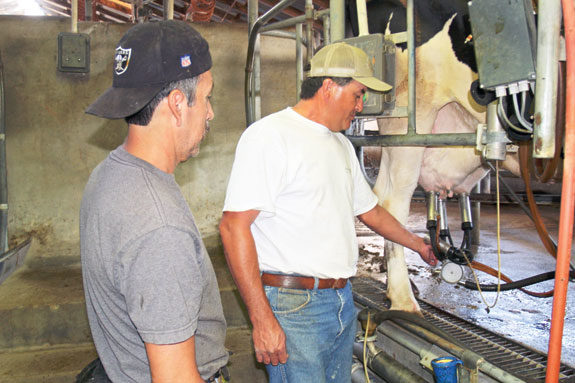There have been many reports on how to cut here and trim there to reduce expenses during these difficult times of lower milk prices and high commodities costs. However, there is a specific part of your dairy enterprise where, instead of cutting back, you should invest more than ever. Effectively training employees can generate a high return for dollars invested. As an example, milking procedures and milk quality training could save you from losing milk quality bonuses, and can reduce the incidence of new mastitis. Reduced mastitis can also save you money that would have been spent to treat the problem.
As more jobs are lost in this economy, many workers may find a niche in agriculture. One common mistake is assuming that because they grew up on a farm or they come from Latin America, they are properly trained to be around dairy animals. Soon it will be springtime, when work increases around the farm; all those heifers are ready to calve, looking for seed and fertilizer. But what about the farm employees?
It is not uncommon for owners to move personnel to different jobs. For example, moving trained employees in the milking parlor. Have you ever looked at how costly this decision could be? Pretend a mastitis case costs $300 (including discharged milk) per incident and a new person in the barn, not properly trained, will detect one or two cases per every 10 actual cases. Eight missed cases at $300 per case comes to around $2,400. You can pay for a lot of training with that amount of money.
Mastitis detection is not the only issue that involves training. Proper milk letdown, milking machine attachment and dairy cattle handling are other issues that should be addressed by training. An article in the Journal of Dairy Science reported that milkers that treated cows gently (kind management) average 1.5 kg (3.3 lb) more milk than milkers who treated cows roughly. In a 1000-cow dairy farm, this represents 1500 kg or 3300 lbs per day.
A major mistake farmers make is in determining who trains new employees. Again, most of the time this task is completed by someone who actually is working on the farm. The goal is to choose someone who is kind, likes to teach others, and best of all, does not teach new employees shortcuts or how to get the job done earlier at the expense of the cows.
In conclusion, there are places where you have to spend money, and training is one of those. Donât think of training as an expense. Think of it as an investment that can improve your business, increase efficiency of milk production and get the most from your inputs. PD
References omitted due to space but are available upon request to editor@progressivedairy.com .
â Excerpts from Utah State University Extension Dairy Newsletter
PHOTO : Effectively training employees can generate a high return for dollars invested. Photo by PD staff.
Gustavo PeĂąa
Veterinary resident
University of Florida
gpc27@hotmail.com





